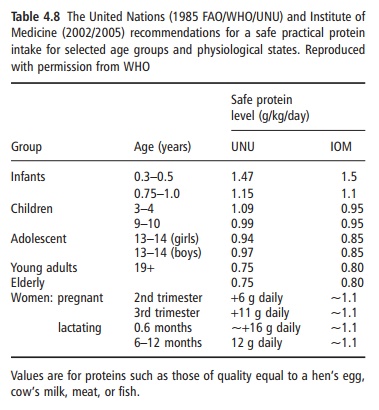Chapter: Introduction to Human Nutrition: Nutrition and Metabolism of Proteins and Amino Acids
Protein requirements for various age and physiological groups
Protein requirements for various age and physiological groups
The protein requirements for young adult men and women have been based on both short- and long-term nitrogen balance studies. This also applies to healthy elderly people, whose protein requirements have been judged not to be different from those of younger adults. In order to make practical recom-mendations to cover the requirements for most indi-viduals, it is necessary to adjust the average or mean requirement for a group by a factor that accounts for the variation in protein requirements among appar-ently similar individuals in that group. This factor is usually taken to be the coefficient of variation (CV) around the mean requirement and traditionally a value of 2 × CV (SD/mean) is added to the mean physiological requirement, so that the needs of all but 2.5% of individuals within the population would be covered. This adjusted requirement value is taken to be the safe practical protein intake for the healthy adult (Table 4.8). Most individuals would require less than this intake to maintain an adequate protein nutritional status.

It is worth emphasizing two points. First, the current UN recommendations shown in Table 4.8 apply to healthy individuals of all ages. However, it is highly likely that the needs of sick or less healthy patients would differ from and usually exceed those of healthy subjects. In this case, the values given in this table can be regarded only as a basis from which to begin an evaluation of how disease and stress, including surgery, affect the needs for dietary protein. Unfortunately, the quantitative needs for protein (total nitrogen) in sick, hospitalized patients can be only very crudely approximated at this time.
Second, the values shown in Table 4.8 apply to high-quality food proteins, such as eggs, milk, meat, and fish. The differing nutritional value of food pro-teins will be considered below.
Related Topics